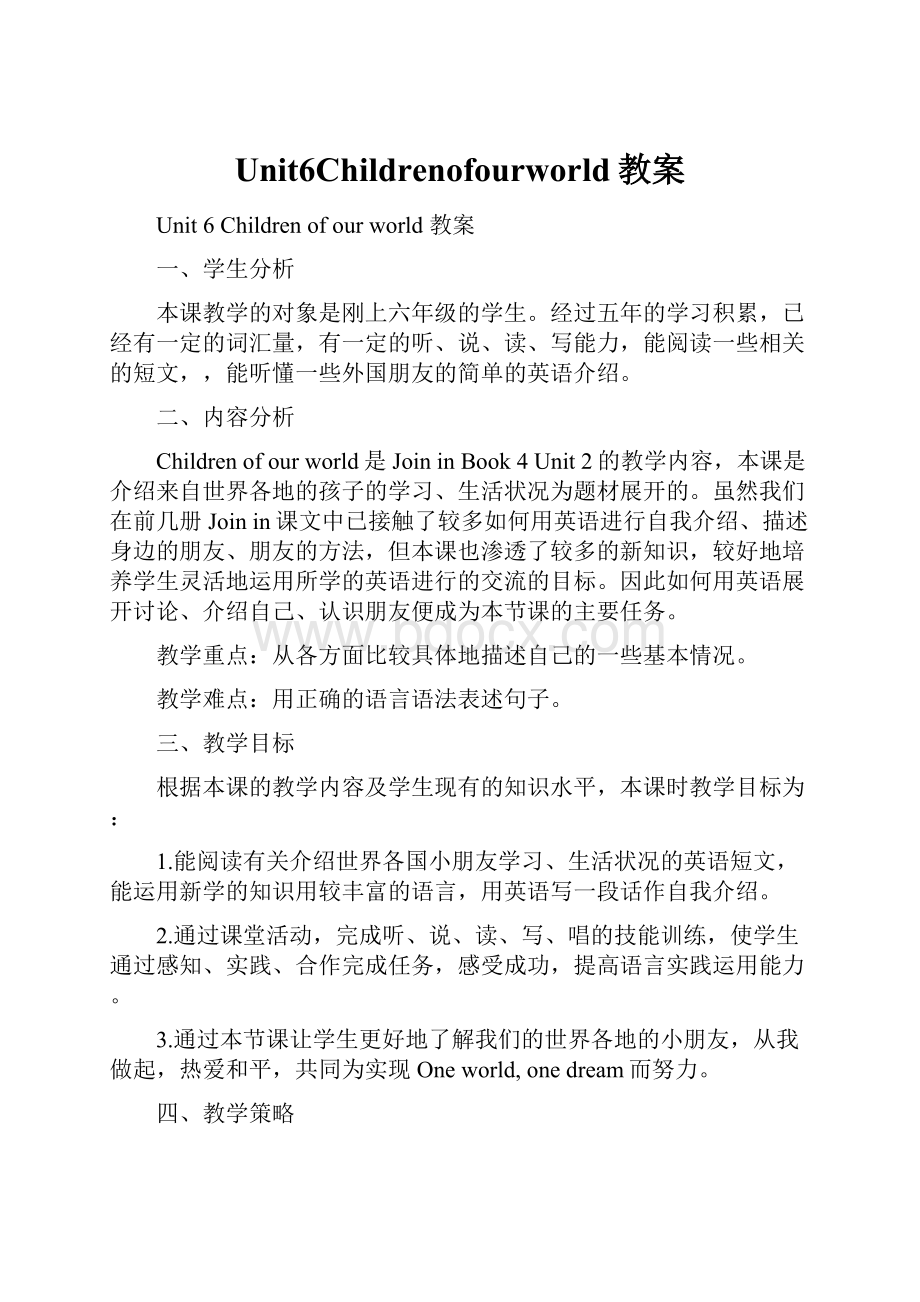Unit6Childrenofourworld教案.docx
《Unit6Childrenofourworld教案.docx》由会员分享,可在线阅读,更多相关《Unit6Childrenofourworld教案.docx(22页珍藏版)》请在冰豆网上搜索。

Unit6Childrenofourworld教案
Unit6Childrenofourworld教案
一、学生分析
本课教学的对象是刚上六年级的学生。
经过五年的学习积累,已经有一定的词汇量,有一定的听、说、读、写能力,能阅读一些相关的短文,,能听懂一些外国朋友的简单的英语介绍。
二、内容分析
Childrenofourworld是JoininBook4Unit2的教学内容,本课是介绍来自世界各地的孩子的学习、生活状况为题材展开的。
虽然我们在前几册Joinin课文中已接触了较多如何用英语进行自我介绍、描述身边的朋友、朋友的方法,但本课也渗透了较多的新知识,较好地培养学生灵活地运用所学的英语进行的交流的目标。
因此如何用英语展开讨论、介绍自己、认识朋友便成为本节课的主要任务。
教学重点:
从各方面比较具体地描述自己的一些基本情况。
教学难点:
用正确的语言语法表述句子。
三、教学目标
根据本课的教学内容及学生现有的知识水平,本课时教学目标为:
1.能阅读有关介绍世界各国小朋友学习、生活状况的英语短文,能运用新学的知识用较丰富的语言,用英语写一段话作自我介绍。
2.通过课堂活动,完成听、说、读、写、唱的技能训练,使学生通过感知、实践、合作完成任务,感受成功,提高语言实践运用能力。
3.通过本节课让学生更好地了解我们的世界各地的小朋友,从我做起,热爱和平,共同为实现Oneworld,onedream而努力。
四、教学策略
这节课主要通过任务型教学法和情景教学法,为学生的学习营造真实的语言环境,让学生通过游戏、交流等方式,轻松地掌握教学内容。
五、教学过程
Step1.Warmup.
1.Greetings.
(通过相互问好,拉近与学生的距离。
)
2.Singthesong“we’rethechildrenofourworld”together.
(歌曲让学生复习之前学过的内容的同时,还有利于让学生尽快进入上课的状态。
)
3.TheteachergivessomeinformationofthechildreninPart1andPart4.Thepupilsguesswhotheteacheristalkingabout.
Ex.T:
Helivesonafarm.Hecannotgotoschooleveryday.Who’sthat?
Ps:
Mark.
T:
Sheloveslearning.Shethinksschoolisveryimportantforher.
Ps:
Samshaad.
T:
Heistwelveyearsold.HedreamsofplayingintheAmericannationalteamoneday.
Ps:
Jimmy.
T:
Shegetsupatfiveo’clockandhastosellfruitsinthestreets.
Ps:
Lena.
……
(通过这个环节,可以让学生对前几个课时的知识进行总结,同时还可以加深学生对自我介绍的理解及认识,为他们之后的写作作积累,提供语言输入。
)
Step2.Presentation.
1.Theteacherintroducesafriendtothepupils.
T:
YesterdaywhenIvisitawebsite,ImetaboyfromFrance.HewantstomakefriendswithChinesechildren.WouldyouliketoknowabouttheboyandFrance?
Let’svisitandlistentoittogether.(ShowthePPT)
(创设较真实的语言环境,为学生提供适当的语言条件,激发学生的求知欲望及学习兴趣。
)
Hello!
IamMargaret.IamaFrenchpupil.I’mtwelveyearsold.
Iamstudyingatafamousprimaryschool.Ourschoolstartsat8:
30inthemorning.Igohomeat5:
00intheafternoon.From11:
30to2:
00Ihavelunchandhaveabreakatschool.Ilikesports.Afterschool,Ioftenplaybasketballwithmyclassmates.
Canyouguesshowmanyfamilymembersthereareinmyfamily?
Five!
Myfather,mymother,mybrother,mypetdog,andI.Ilikemypetdogverymuchandtreathimasoneofmyfamilymembers.
Ihaveagoodfriend.HisnameisRoy.Heiselevenyearsold.Weoftenplaybasketballtogether.
HaveyouevertastedFrenchfood?
It’sdelicious!
Ilikeitverymuch.Onweekdays,bothmyfatherandmothergotowork,butonweekends,nomatterhowbusytheyare,weoftenhavedinnertogether.MyfatherlikesFrenchwineandchampagne.
Thepupilsreadtheintroductionoftheboy.Thenfillintheblankingroups.(学生小组活动)。
Name
Margaret
Age
Day
School
Lunch
Gohome
Afterschool
Family
Member
Pet
Friend
Name
Age
Hobby
Weekdays
Weekends
(阴影部分为学生填写内容)
(通过阅读短文,为学生提供模仿的例子,利用表格让学生提取相关的信息,同时也提示了学生写作的纲要。
让学生更有条理地整理好自己的思维,为以下的写作作好准备。
)
2.Checktheanswerswiththewholeclass.
( 通过对答案,可以跟学生进行一些交流,如问到年龄一栏时,可以顺势过渡到问学生的真实年龄,howoldareyou?
并把问题逐一贴在黑板上,以便成为学生在写作时的提示。
)
Step3.Practice.
1.Talkwithpartners.Thepupilsaskandanswerinpairsaccordingtothequestionsontheblackboard.
(给每组学生一套问题纸条,轮流抽签,用自己抽到的问题提问对方。
通过生生之间的问答,让他们用口头描述自己的一些基本情况。
利用游戏的方式,使枯燥的问答活动变得有趣味性。
)
2.Askthepupilstowritedowntheinformationaboutthemselvesintheform.Thentalkaboutthemselvesingroups.
(通过口头练习,让学生相互交流学习,为之后的写作作准备。
)
Step4.Writeanintroductionofoneself.
T:
Let’smakefriendswithRusshell.Writeaboutyourselfandputitontheinternet.Maybewecanmakemanyfriendsallovertheworld.
(此任务的布置能激发学生的写作兴趣,让他们更投入地对自己进行描述。
)
Step5.Assessment.
展示一到两篇学生作品,及时给予批改,通过检查,教师能初步得到学生对本课的学习情况反馈。
Step6.Homework.
1.Completetheintroductionofyourself.
2.Introduceyourselftoyourparents.
Unit4Accidents教案
TeachingAimsandGoals:
1.Letstudentsknowthenewwords
2.Recitesomeimportantsentences.
3.Understandthegrammarofthisunit.
Teachingimportantpoints:
1.Gooverwordsandphrasesandpassivevoice:
2.Newsentences:
1).wanttobethevictim.
2).Thevictimisthepersonwhoishurt.
3).Whydon’tyoupretendtobeJenny’sfriend?
4).Idon’thavetopretend.
5).Whydidn’tyoulistentomywarning?
6).Nowyou’vehadanaccident!
7).Don’tbemad.Beanicefriend.
8).TakecareofJenny.=LookafterJenny.
9).Areyoubadlyhurt,Jenny?
10).Itwillkeepyouwarm.
11).Don’tbescared.12).Didyouseehowthisaccidenthappened?
Teachingdifficultpoints:
1.Letstudentsknowhowaccidentshappened?
2.ToknowtheusageofGrammarofthisunit.
Teachingtools:
(教具)
Recorder,Audiotape,andPowerPoints
TeachingSteps:
(教学过程)
Step1:
Lead-in
Showsomepicturesaboutaccidentonthebook,leadinthenewlesson
Step2:
Revision
1).ReviewwordsandphrasesinUnit5.
2).Reviewthepassivevoiceofunit5
Inthispart,letstudentsfinishexercisesonPPT.
Step3:
Learnnewwords
Accident,acting,victim,pretend,warning,refuse,reporter
Step4:
Cometo“Thinkaboutit”,andanswerthequestionsonPPT
Step5:
Listening.
Playtheaudiotape.HavetheclassfollowtheaudiotapewhileAnswerthequestions,thequestionsareonPPT.
Step6:
Reading
Findoutthreestudents,andaskstudentstoreadthedialogue.
Step7:
Exercise(练习)
FinishoffexercisesonPPT.
Step8:
Cometo“Project.”
Withasmallgroupofclassmates,youwillpretendthatsomeonehashadanaccident.Eachpersoninyourgroupwillpretendtobesomeonedifferent.
Øthevictim
Øsomeonewhosawtheaccident
Øadoctor
Øareporter
Don’tforgettoshowyourclassmates:
Øhowtheaccidenthappened
Øwhathappensnext
Iftherehavenoenoughtime,letthispartmakestudents’homework.
Step10:
Homework
1.Learnthewordsandphrasesinthislessonbyheart.
2.Finishthefollowingexercises.
Unit2Bigcities教案
一、教学设计
1、学生分析
本节课的授课对象为六年级三班的学生。
该年龄段的孩子注意力较集中,较了解自己的记忆过程,较强的元记忆能力使他们能选择更适合的策略来完成任务。
虽然此阶段的学生思维的基本过程日趋完善,但不同的学生认知能力方面仍存在不同的差异。
本班学习气氛较浓厚,但两极分化较严重,后进生常要在优生的带领下才能较好地完成任务。
对于此次教学内容,课前,学生已经通过XX搜索收集了北京各个景点的资料,学习过世界其它国家一些大城市的情况,也了解了我国上海的概况。
本节课,他们将仿照例文写一篇介绍北京的文章。
2、内容分析
本单元教学内容主要围绕城市展开,重点学习如何简单地介绍一个地方有什么景点(Thereare/Thereis…),人们可以干什么(Youcan/Wecan…)。
通过本单元的学习,可以进一步加强学生对Therebe句型的运用,也把一些表示动作的词语运用到实际生活中去,提高了学生语言的综合表达能力。
课前,学生通过几个课时的学习,已基本把握与之相关的词汇,并能较为熟练地运用Thereare/Thereis…的句型。
这节课是本单元的最后一个环节,要求学生仿照例文写一篇文章介绍北京,其中“人们可以在这个城市做什么”是写作的难点。
根据本班学生两极分化较严重的情况,本次教学主要采取的是小组互助学习的形式,让学生采用思维导图mindmap的形式突破难点。
例文的学习主要是让学生通过观察、发现和归纳等方式,把握语言的规律,形成有效的学习策略。
3、教学目标
知识目标:
1.能理解例文大意,找出文中的重点词和重点句。
2.能运用Thereare/Thereis…以及Youcan/Wecan…的句型描述北京。
能力目标:
1.能用符号画出文中的重点词和重点句。
2.能与小组的成员交流获得的信息,并合作完成思维导图。
情感目标:
1.培养学生的合作意识,让学生体验合作的愉快。
2.培养学生热爱家乡的美好情感。
二、教学重难点
1.能理解例文大意,找出文中的重点词和重点句。
2.能运用Thereare/Thereis…以及Youcan/Wecan…的句型描述北京。
教学难点:
能运用Thereare/Thereis…以及Youcan/Wecan…的句型描述北京。
三、教学过程
课前一两分钟,边做动作边说有关动作的词语来调动学生的积极性,活跃课堂气氛,也为难点的攻破做好铺设。
(可以做的动作有flyakite,rideabike,readabook,dosomeshopping,haveanicecream等。
)
1.导入。
T:
Todayisaniceday,theweatherisverygood.It’sgoodforustotravelbetweenthecities.Let’shaveatrip.
Let’sreadthetitlewe’regoingtolearn.(教师板书题目BigCites,学生齐读)
2.复习。
(1)T:
Canyoutellmewhichcitydoyouknow?
S:
Rome/NewYork/London/Beijing…
(个别学生回答完后,教师拿出代表城市的图片和单词,全班复习城市名称。
)
(设计意图:
问题比较简单,又是学生学过的知识。
低难度的问题有利于调动学生回答的积极性。
)
(2)T:
Look,hereisaphotoofShanghai.Canyousaysomethingaboutit?
(设计意图:
这是一条开放性问题,学生可以说书本上的内容,也可以讲自己所知道的,初步让学生感知介绍一个城市可以介绍什么。
不要求学生成篇介绍,学生不会胆怯,有利于保持学生的积极性。
)
3.阅读例文。
(1)引出并初次感知例文
T:
Shanghaiisverybeautiful.TodayYoyowantstotellyousomethingaboutthecitywhereshelives.
T:
Nowlistenandtrytogetwhichcitysheistalkingabout?
(设计意图:
教师播放来自练习册的例文的录音一次,学生带任务听。
问题很简单,许多学生可以回答出来。
也可以让学生初步感知文章的整体性。
)
(2)理解例文,并找出文中的重点词句。
T:
Readthetextingroup.
Team1,Team2trytofindoutwhatcanweseeinGuangzhou?
Circlethekeywords.
Team3,Team4trytofindoutwhatcanwedoinGuangzhou?
Underlinethesentences.
(教师贴板书Whatcanweseeinit?
/Whatcanwedoinit?
)(学生四人小组读文章,并带着问题画出重点词句。
教师巡堂帮助。
)
(设计意图:
小组活动有助于发挥学生合作学习的精神,可以让较好的学生帮助成绩后进的同学。
)
(3)汇报。
汇报时,教师引导学生用Therebe以及Youcan/Wecan…的句型来描述。
教师根据学生的回答板书重点词句,板书如下:
)
(4)朗读例文,建立文章的整体印象。
T:
Now,youareYoyo.Let’sintroduceGuangzhou.
(学生先分小组读,然后全班朗读全文。
)
4.介绍北京。
(1)形象感知.
T:
Guangzhouisamoderncity.It’saplaceforyourholiday.IsFoshanabeautifulcity?
S:
Yes.
T:
WhatarethesightsinFoshan?
S:
Liang’sGarden…(一些景点名学生不会说的,老师可以教。
)
(教师边写景点名称,边简单教读。
)
四、作业。
(1)通过XX搜索查阅更多北京各景点的资料,充实文章内容。
(2)小组分享你的文章。
Unit4Accidents
习题1
一、单项选择。
1.WhenIwaseight,I______anaccidentwithmybike.
A.have
B.has
C.had
2._____he_____hisleg?
A.Did,breakB.Did,brokeC.Do,break
3.Hefell_____thewindow.
A.onB.atC.from
二、翻译。
1.去年我和父母在伦敦度假。
______________________
2.Mymumputabandageroundit.
______________________
3.你怎么啦?
______________________
Unit5Animalsindanger
习题2
一、根据图片写出下列动物。
1.__________
2.__________
3.__________
4.__________
二、完成句子。
1.is,in,water,rivers,dirty,The,many
______________________.
2.China,The,lives,pandas,in
______________________.
Unit3Festivals
习题2
一、根据图片写出单词或节日。
1.__________
2.__________
3.__________
4.__________
二、完成句子。
1.children,on,What,do,do,Halloween,the
______________________?
2.house,from,go,Children,house,to
______________________.
Unit1Schoolisgreatfun教案
一、Teachingaims
1.Knowledgeaims
能根据已学语音、音标及发音规则,正确朗读下列词汇并在实际的对话操练中加以应用:
By,fan,dialogue,geography,history,language,nice,play,pop,south.
能够在口头和书面表达中,复习和区分现在进行时及一般现在时的用法;
能够就“谈论校园生活、课程及时间表”的话题进行交流与对话操练,如:
(1)—whatclassaretheyhaving?
—Theyarehavingamusicclass.
(2)—howmanylessonsdoeshehaveeveryweekday?
—Five.
(3)—whattimedoesthenextclassbegin?
—Attenfifty-five.
2.Skillaims